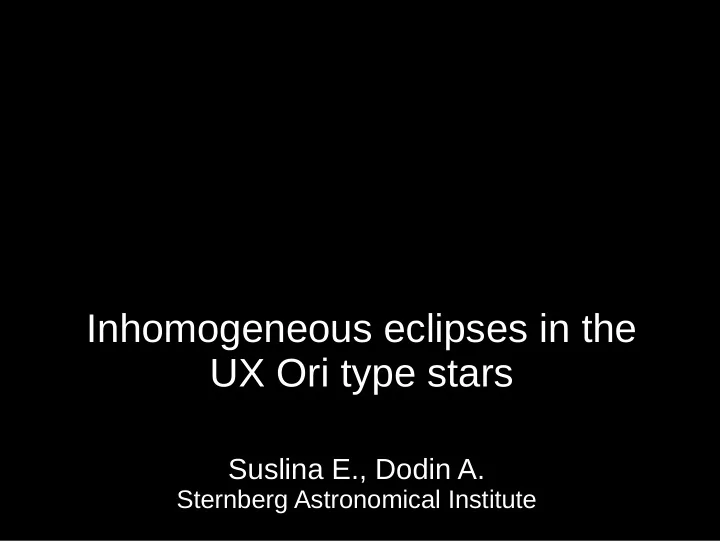

1 Inhomogeneous eclipses in the UX Ori type stars Suslina E., Dodin A. Sternberg Astronomical Institute
2 Rossiter-McLaughlin (RM) effect All lines undergo the same kind of the distortion (up to the variations of the limb darkening law in different lines) J. Winn, 2011 UX Ori: V. Grinin, I. Potravnov, 2013 for RZ Psc
3 Variability of LSD profiles CQ Tau PAR 1414 RY Ori F. Villebrun et al., 2019
4 CQ Tau SME (Piskunov, Valenti, 2016)
5 All lines show the same kind of distortion, as expected for RM effect: 22.12.2012 25.12.2012 22.12.2012 28.12.2012 22.12.2012 29.12.2012 ESPaDOnS
6 Modelling – SME – rigid rotation of spherical star – standard extinction law
7 EW 0 EW EW EW 0
8
9
10
11
12 The differences in lines give the information about cloud’s shape The pattern of variability gives information about the direction of movement
13 Modelling Due to the inhomogeneous eclipses the line profiles show complex shape with narrow features – as was observed CQ Tau: CaI 6122 22.12.2012 25.12.2012
14 Consequences of inhomogeneity Star’s properties are affected: Radial velocity and v sin i distortion T , log g, V Parameters of the star ( ) are eff mic slightly distorted due to differences in limb darkening in weak and strong lines: ( EW strong ) 0 ≠ ( EW strong ) eclipse EW weak EW weak
15 Consequences of inhomogeneity Dust properties: Inhomogeneous eclipses are tend to be more grey, leading to incorrect conclusion about the mean size of dust grains: (Natta, Panagia, 1984) f = 0.9 A = 3 , for standard extinction V Cardelli, Clayton & Mathis, 1989 A 2.5log 1 f + f 2.512 λ
16 A simulated Ha image of Consequences accreting CTTS with an outflow (Kurosawa et al., 2006): Distortions observed in absorption lines The same, but with clouds: should be present in the emission lines:
17 Conclusions 1. Obscuring clouds are structured on the scales of stellar radii 2. Differences in line profiles give an opportunity to map the clouds 3. Series of observations within one night will make the study of clouds movements possible
18 Thank you for your attention! Supported by RSF 17-12-01241
Recommend
More recommend